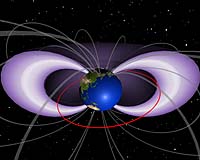New Mars Forums
You are not logged in.
- Topics: Active | Unanswered
Announcement
#1 2004-07-08 14:01:42
- Palomar
- Member
- From: USA
- Registered: 2002-05-30
- Posts: 9,734
Re: Fastest Space Storm - ...On Record Plows through Solar System
http://www.space.com/scienceastronomy/s … ml]Reaches edge of Solar System
*This storm a result of the massive CME events last October/November. Wow.
Article discusses possible stripping away of Mars' atmosphere in the distant past from a similar event or events.
--Cindy
::edit:: "Later this year the blast should reach the true edge of the solar system, some 3-4 billion miles (4.8-6.4 billion kilometers) beyond Voyager 1. There the storm will meet head-on with a wave of interstellar particles at what's called the heliopause. Radio disturbances caused by that interaction then might be picked up by the Voyager craft, giving scientists their first measurement of where the edge really is."
"The Cassini spacecraft, then past Jupiter en route to Saturn, recorded the sound of one storm swooshing by less than two hours after the eruption."
"Astronauts aboard the International Space Station took cover multiple times in protected areas."
We all know [i]those[/i] Venusians: Doing their hair in shock waves, smoking electrical coronas, wearing Van Allen belts and resting their tiny elbows on a Geiger counter...
--John Sladek (The New Apocrypha)
Offline
Like button can go here
#2 2004-12-16 07:35:08
- SpaceNut
- Administrator
- From: New Hampshire
- Registered: 2004-07-22
- Posts: 29,957
Re: Fastest Space Storm - ...On Record Plows through Solar System
Update to this story:
Scientists find atmospheric erosion
This was something I know I had speculated to under another thread with regards to why Mars may have lost most of its atmosphere.
So much for the protective radiation belts that reside between 4000 to 8000 miles from Earth.
Edit:
Earth's Safe Zone Became Hot Zone During Legendary Solar Storms
Space weather matters -- we now know that no matter what orbit we choose, there is the possibility that a spacecraft could get blasted by a significant dose of radiation. We need to take this into account when designing spacecraft. We also need to the ability to continuously monitor space weather so satellite operators can take protective measures during solar storms

Offline
Like button can go here